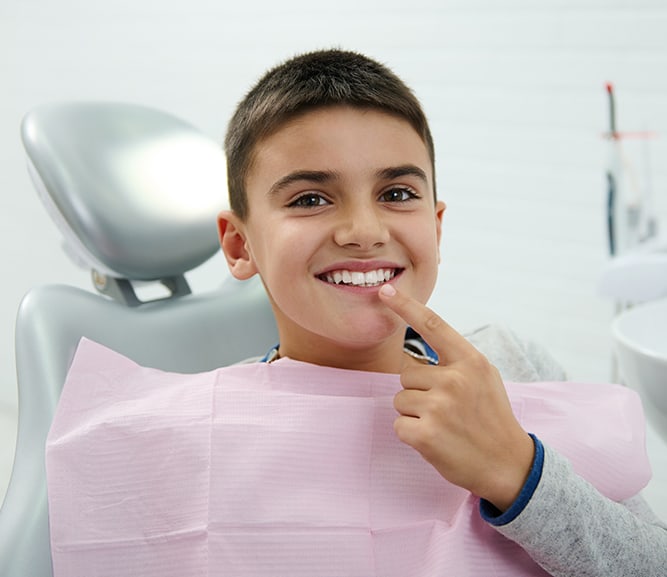Preventive Dental Care for Growing Smiles
A positive dental experience early in childhood can set the stage for a lifetime of healthy habits for your kids. Our team creates a welcoming and positive experience for kids of all ages, helping them develop good habits and build trust in dental care.
Regular checkups help prevent cavities and support healthy development. We recommend that children start seeing the dentist by their first birthday, and then return once a year or more often as advised by Dr. Scott.
From toddler teething tips to teen hygiene guidance, we’re your partners in building strong, healthy smiles. Contact us to schedule your child’s next exam today.
Book AppointmentWhat to Expect During Your Child’s Visit
During your child’s exam, we will:
- Thoroughly clean their teeth
- Check for early signs of tooth decay or gum problems
- Take X-rays if needed
- Apply fluoride treatment or sealants when appropriate
- Offer tips for home care based on age and habits
We take time to answer questions so that both children and parents feel comfortable at every visit.

Dental Care for Every Stage of Childhood
Your child’s oral health journey starts long before their first tooth, and every stage brings new milestones and challenges. From teething infants to independent teens, we’re here to support your family with advice, gentle care, and helpful tips to make home routines easier.
At Riverwalk Dental, we tailor our guidance to your child’s age and stage, so you always know what to expect and how to keep their smile healthy at every step.
Even before teeth come in, oral care matters. After feeding, gently wipe your baby’s gums with a soft, damp cloth. Once the first tooth erupts, usually around 6–9 months, begin brushing daily with a soft baby toothbrush and water.
Helpful tips for parents:
- Avoid letting your child fall asleep while feeding
- Don’t put milk or juice in bottles at bedtime; use only water
- Keep an eye out for signs of teething and use chilled teething rings or gentle gum massage to soothe discomfort
Untreated cavities in infants can lead to infection or impact overall health. Early visits help us prevent and catch issues before they become serious.
As more teeth come in, your child’s routine becomes even more important. This is the time to build healthy brushing and eating habits.
Our tips:
- Brush your child’s teeth twice a day with a soft brush
- Introduce flossing once the teeth are touching
- Limit sugary drinks and snacks to mealtimes only
- Replace toothbrushes every 1–3 months or after illness
- Supervise brushing and avoid using toothpaste before age 3 unless advised by your dentist
For kids 3 and up, a small amount of fluoride toothpaste (about the size of a pea) can be used. Encourage your child to spit it out rather than swallow.
Permanent teeth usually begin coming in around age 6. These years are key for developing independence and reinforcing good oral hygiene.
How to protect your child’s smile:
- Brush twice a day and floss once a day
- Limit sugar intake and avoid grazing between meals
- Wear a mouthguard during sports and activities
- Continue with regular dental exams and cleanings
We also monitor for orthodontic issues and can provide referrals if needed.
Book Your Child’s Next Visit
A calm, caring approach makes all the difference. At Riverwalk Dental, we’re here to support your child’s health from their first tooth through their teen years. Whether it’s your baby’s first visit or your teen’s routine check-up, we’re here to make every experience feel calm, supportive, and fun.
If you’re ready to book an appointment or would like to learn more about pediatric dental care, please contact us today!
Book AppointmentServices That Cover
What You Need

Find Us in the Heart
of East Village
Come Visit Us
We are conveniently located in Calgary’s East Village. Swing by and visit the team today!
Where to park?
Street parking is available out front, and our team will happily cover the costs of your parking. Talk to our team for more information.
Our Address
- 540 6 Ave SE
- Calgary , AB T2G 1K5
Contact Information
- Phone: 403-456-4994
- Email: info@riverwalkdental.ca
Hours of Operation
*Friday By Appointment Only




